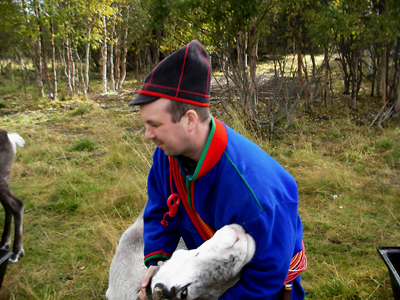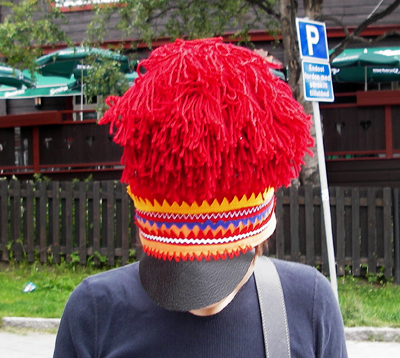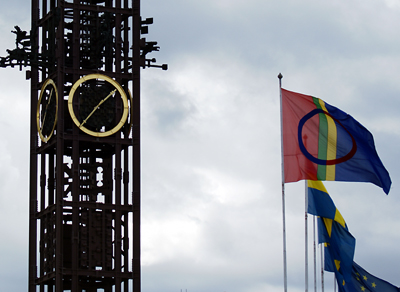Sami Posted by Transparent Language on Aug 6, 2008 in Culture
I said last time that I would tell you about the Sami. In fact, I’ve been thinking about a Sami-themed post for quite a while now, or at least every time I listen to Transjoik. Though Transjoik is technically a Norwegian band, we’ll let them in here on an honorary membership. Sami, the people formerly known as Lapps don’t recognize normal national borders. They live in Norway, Sweden, Finland and Russia. But who are they?
In Swedish:
- samer (noun plural, def. plural: samerna) – en folkgrupp som finns i norra Sverige, Norge, Finland och Ryssland – an ethnic group in northern Sweden, Norway, Finland and Russia.

This happy Sami guy, Lars Jonas Johansson, lives nearby Tärnaby and welcomes visitors into his home. Just bring rubber boots if you plan to pet his reindeer – they sure poop a lot.
In short, they are an indigenous people of Northern Europe, and they have inhabited the northern regions of Scandinavia and Russia for a couple thousand years at least. Nobody is really sure when exactly they arrived in the area and from exactly where. Their DNA has been studied extensively, but the results are confusing.
The language, or rather languages that the Sami people speak are equally confusing. Technically, the language is called Sami, but it has so many subdivisions that a group speaking one dialect may not understand another. Fortunately for the rest of us, these days the Sami people also speak Swedish, or Norwegian, or Finnish, or Russian. Or if you’re really intent on mastering one of the Sami languages, then the university in Umeå has just the course for you.

Your writer modeling a traditional Sami hat. The hat was made by an old woman – Inga Idivuoma, who is famous around Kiruna for her hand-made accessories. Unfortunately, she no longer makes them due to arthritis in her hands, and there are no young kids around willing to learn the craft and take over her business.
In Swedish:
- samiska – samernas språk – the Sami language
When living or traveling in northern Sweden, sooner or later you will encounter a Sami person. The further north you go, the easier it becomes. And when you get up to Kiruna, you will see Sami flags proudly displayed in many locations. It shouldn’t be a surprise then that the Sami Parliament in Sweden is located in Kiruna.

Sami flag fluttering in the wind next to the clock tower in Kiruna
You can read more about the Sami people here. No worries, it’s in English and much more eloquently written than anything I could have come up with.
I’m guessing that most of your contact with the Sami will be either thanks to reindeer (herding reindeer is an ancient Sami occupation) or through music. And that’s how we come to yoik.
In Swedish:
- jojk (noun, def: jojken, plural: jojkar, plural def: jojkarna) – en sorts samisk sång utan ord – a type of Sami song without words.
Why is it without words? Because a typical yoik is similar to “throat singing” or chanting in certain cultures. It can be very personal and deeply spiritual in nature. Sounds boring? It’s not. Check out the Transjoik link here. This traditional form of singing lends itself very nicely to an ethno-folk-trans beat.
This is just a short introduction to the Sami culture on this blog, and as I come across interesting Sami subjects, I will feature them here along with other Swedish things. Like it or not, the Sami are an integral part of northern Sweden. You can’t live in Norrland and not talk about the Sami. And trust me, there’s a lot to talk about.

Build vocabulary, practice pronunciation, and more with Transparent Language Online. Available anytime, anywhere, on any device.




Comments:
ceci:
is it jojk a kind of “om”? i guess so…thanks again, ceci
Anna:
ceci,
I’m not familiar with “om”, but have you ever heard Central Asian throat singing? Jojk is similar. Part yodeling and part throat singing.
margaret aston:
Hej Anna, I am sorry to trouble you but I am absolutely tearing my hair out. I am in Sweden and going home Thursday 14th Aug. I want to make a special meal for my husband, as due to health problems he cannot come back to Scotland with me, and need to purchase some self raising flour, my Swedish is not so good and I can find the translation for flour, but have tried everywhere known to me for self raising with no luck can you help. please email me if you can help I would like to make this meal tomorrow 13th Aug. I know its short notice and would appreciate any help that you or anone esle reading this can give. M from Scotland thank you in advance.
Anna:
Hej Margaret!
self-raising flour in Swedish is: “vetemjöl med bakpulver”. It simply means that baking powder is already mixed in. I know that the Kungsörnen brand has a 1 kilo package of that type of flour. I tried to look on their website to show you what it looks like, but sorry, their page is so primitive it wouldn’t even load properly on my computer.
The packages is mostly red, and if I remember correctly, in the top right corner it says something like “med bakpulver”, which means “with baking powder”. That’s the kind of flour you need.
I hope this helps!
Just write it down and show the note to anyone working at your local store, they should be able to point you in the right direction. Good luck! 🙂
Ida:
Dearvva!
Ferte jearrat, hállágo giige dáppe
Sámegiella? Lean lohkamin Sámegiella.
In liiko Ruoŧŧagiellas. Buđetsmákuid <3
mmm… ….Fuotni muitu… Mun lean easkka
njealljenuppelohkái.
Hmm.. Eadni váldde sallii. Outi Pieski 2005.